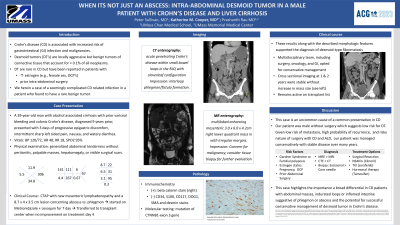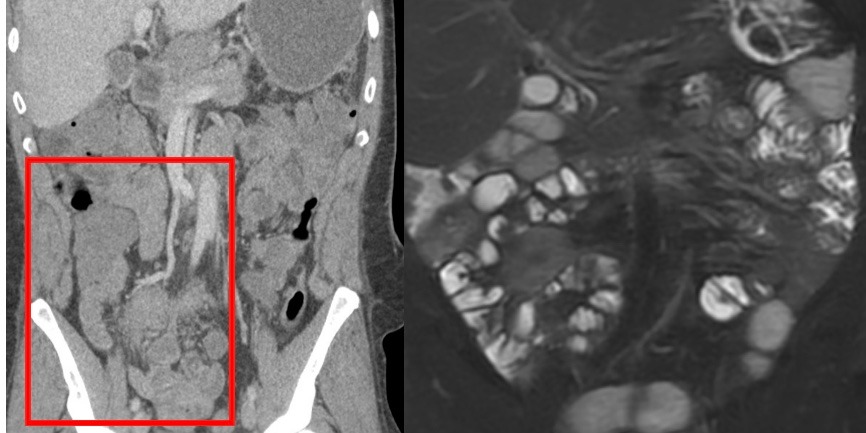Tuesday Poster Session
Category: IBD
P3682 - Intra-Abdominal Desmoid Tumor in a Male Patient With Crohn’s Disease and Liver Cirrhosis: It’s Not Always an Abscess
Tuesday, October 24, 2023
10:30 AM - 4:00 PM PT
Location: Exhibit Hall

Has Audio

Katherine M. Cooper, MD
UMass Chan Medical School
Worcester, MA
Presenting Author(s)
Peter Sullivan, MD, Katherine M.. Cooper, MD, Prasthanth Rau, MD
UMass Chan Medical School, Worcester, MA
Introduction: Crohn’s disease (CD) is associated with increased risk of gastrointestinal (GI) infection and malignancies. We herein a case of a seemingly complicated CD related infection in a patient who found to have a rare benign tumor.
Case Description/Methods: A 39-year-old man with alcoholic cirrhosis and colonic CD’s (diagnosed 9 years prior) presented with 3 days of progressive epigastric discomfort, intermittent sharp left sided pain, nausea, and watery diarrhea. Physical examination was notable for generalized abdominal tenderness without peritonitis, palpable masses, hepatomegaly, ascites, or visible surgical scars. Laboratory evaluation was unremarkable. A CTAP was obtained and showed new mesenteric lymphadenopathy and a 9x4x4 cm lesion in the right lower quadrant (RLQ), concerning for a phlegmon and intra-abdominal abscess. He received 1 week of Metronidazole and Levaquin without improvement prompting further evaluation. Repeat CTAP was concerning for penetrating CD in the small bowel and cloverleaf configuration concerning for interloop phlegmon/fistula formation in the right lower quadrant. However, subsequent MRE revealed an enhancing mesenteric mass with irregular margins measuring 3.0 x 6.0 x 4.2 cm in the RLQ, most concerning for malignancy. A CT guided core needle biopsy was obtained, and pathology demonstrated lesional cells with nuclei positive for beta catenin. Molecular testing notable for a mutation in the CTNNB1-exon 3 gene. Together, the findings were most consistent with desmoid-type fibromatosis. After multidisciplinary discussion with surgery, oncology, and GI, the patient was managed conservatively without further complications.
Discussion: Desmoid tumors (DT’s) are locally aggressive but benign tumors of connective tissue that account for < 0.1% of all neoplasms. DTs may be associated with FAP, pregnancy, and prior abdominal trauma, but association with CD is not established. The few reported cases have been in patients with increased estrogen (e.g., female, OCP’s) or with prior intra-abdominal surgery. Our patient is unique in that he is male with CD who developed a DT in the absence of prior intra-abdominal surgeries. It is possible that a high estrogen state in the setting of cirrhosis contributed to development. This serves to highlight the importance of a broad differential including DT in with CD patients presenting with abdominal masses, indurated loops or inflamed intestine suggestive of phlegmon or abscess.

Disclosures:
Peter Sullivan, MD, Katherine M.. Cooper, MD, Prasthanth Rau, MD. P3682 - Intra-Abdominal Desmoid Tumor in a Male Patient With Crohn’s Disease and Liver Cirrhosis: It’s Not Always an Abscess, ACG 2023 Annual Scientific Meeting Abstracts. Vancouver, BC, Canada: American College of Gastroenterology.
UMass Chan Medical School, Worcester, MA
Introduction: Crohn’s disease (CD) is associated with increased risk of gastrointestinal (GI) infection and malignancies. We herein a case of a seemingly complicated CD related infection in a patient who found to have a rare benign tumor.
Case Description/Methods: A 39-year-old man with alcoholic cirrhosis and colonic CD’s (diagnosed 9 years prior) presented with 3 days of progressive epigastric discomfort, intermittent sharp left sided pain, nausea, and watery diarrhea. Physical examination was notable for generalized abdominal tenderness without peritonitis, palpable masses, hepatomegaly, ascites, or visible surgical scars. Laboratory evaluation was unremarkable. A CTAP was obtained and showed new mesenteric lymphadenopathy and a 9x4x4 cm lesion in the right lower quadrant (RLQ), concerning for a phlegmon and intra-abdominal abscess. He received 1 week of Metronidazole and Levaquin without improvement prompting further evaluation. Repeat CTAP was concerning for penetrating CD in the small bowel and cloverleaf configuration concerning for interloop phlegmon/fistula formation in the right lower quadrant. However, subsequent MRE revealed an enhancing mesenteric mass with irregular margins measuring 3.0 x 6.0 x 4.2 cm in the RLQ, most concerning for malignancy. A CT guided core needle biopsy was obtained, and pathology demonstrated lesional cells with nuclei positive for beta catenin. Molecular testing notable for a mutation in the CTNNB1-exon 3 gene. Together, the findings were most consistent with desmoid-type fibromatosis. After multidisciplinary discussion with surgery, oncology, and GI, the patient was managed conservatively without further complications.
Discussion: Desmoid tumors (DT’s) are locally aggressive but benign tumors of connective tissue that account for < 0.1% of all neoplasms. DTs may be associated with FAP, pregnancy, and prior abdominal trauma, but association with CD is not established. The few reported cases have been in patients with increased estrogen (e.g., female, OCP’s) or with prior intra-abdominal surgery. Our patient is unique in that he is male with CD who developed a DT in the absence of prior intra-abdominal surgeries. It is possible that a high estrogen state in the setting of cirrhosis contributed to development. This serves to highlight the importance of a broad differential including DT in with CD patients presenting with abdominal masses, indurated loops or inflamed intestine suggestive of phlegmon or abscess.

Figure: CT assessment of abdominal pain demonstrating right lower quadrant mass concerning for infection, later diagnosed as desmoid tumor.
Disclosures:
Peter Sullivan indicated no relevant financial relationships.
Katherine Cooper indicated no relevant financial relationships.
Prasthanth Rau indicated no relevant financial relationships.
Peter Sullivan, MD, Katherine M.. Cooper, MD, Prasthanth Rau, MD. P3682 - Intra-Abdominal Desmoid Tumor in a Male Patient With Crohn’s Disease and Liver Cirrhosis: It’s Not Always an Abscess, ACG 2023 Annual Scientific Meeting Abstracts. Vancouver, BC, Canada: American College of Gastroenterology.

